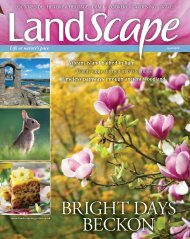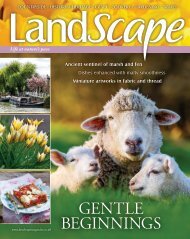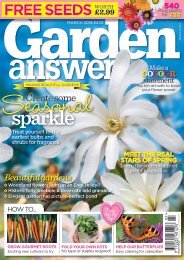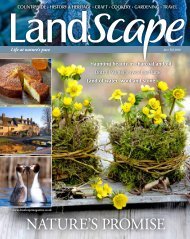LandScape
You also want an ePaper? Increase the reach of your titles
YUMPU automatically turns print PDFs into web optimized ePapers that Google loves.
<strong>LandScape</strong> - Life at nature’s pace Moated garden | Lavender | Cosmos | Picnic food | Rock pooling | Nettles | Canal restoration | Swan upping | Lynmouth to Porlock | Limestone pavement July / Aug 2017<br />
Life at nature’s pace<br />
On sale 14 June-1 August<br />
Issue 40 | July / Aug 2017 | £4.50<br />
Rocks of Solitude on a wild Scottish river<br />
Imprinting the countryside in clay<br />
A haven among nature’s needles<br />
www.landscapemagazine.co.uk<br />
£4.50 July / Aug 2017<br />
WIN<br />
A LUXURY 2-NIGHT<br />
BREAK IN THE<br />
MALVERN HILLS<br />
*T&Cs APPLY<br />
LAYERS OF<br />
SUNSHINE
Contents<br />
July / August 2017<br />
38<br />
10<br />
In the garden<br />
In the kitchen<br />
28<br />
Craft<br />
10 Seas of scented lavender<br />
18 A Norfolk moated garden<br />
34 The garden in July and August<br />
38 A picnic feast<br />
48 Fruit-filled jellies<br />
54 Regional & Seasonal:<br />
Applecross Walled Garden<br />
28 Blithely beautiful cosmos<br />
60 Patchwork picnic blanket<br />
62 Imprinting the countryside in clay<br />
4
90<br />
60<br />
98<br />
Country matters<br />
70<br />
History and heritage<br />
Regulars<br />
56 Rock pooling for seaweed<br />
70 The beneficial nettle<br />
90 From castle ruins to the<br />
Rocks of Solitude<br />
114 Nature’s pavements<br />
76 Restoring a canal<br />
84 Ancient tradition of swan upping<br />
98 The Severn’s last heritage fishery<br />
104 On the edge of Exmoor<br />
6 Readers’ letters<br />
8 Our <strong>LandScape</strong><br />
26 In the garden<br />
46 Subscription offer<br />
52 In the kitchen<br />
68 In the home<br />
120 UK events<br />
5
Lavandula x intermedia<br />
‘Grappenhall’ with<br />
Lavandula angustifolia<br />
‘Elizabeth’ and ‘Little<br />
Lady’. They grow happily in<br />
terracotta pots surrounded<br />
by grit-enhanced compost.<br />
A pollinator bee on nectar-rich, longflowered<br />
L. x intermedia ‘Sussex’.<br />
Spikes of up to 1½in (4cm) long deep purple<br />
Lavandula angustifolia ‘Hidcote’.<br />
SCENTED SEAS IN BLUE,<br />
PURPLE AND WHITE<br />
Billowing waves of cool-hued lavender lend their sweet<br />
fragrance to the flourishing summer garden
LIGHT AND FRESH<br />
Packed with fruit, these recipes turn traditional<br />
jelly into flavour-filled summer desserts<br />
Raspberry jelly<br />
Serves 8<br />
325g raspberries<br />
8 sheets of gelatine<br />
650ml clear apple juice<br />
Pour the apple juice into a large saucepan and heat until<br />
simmering. Simmer for 1 min, until warm. In a bowl, cover<br />
the sheets of gelatine with cold water and leave to stand<br />
for 5 mins. Drain, squeezing the water out of the gelatine<br />
sheets, and add to the apple juice. Stir, then allow to cool<br />
to room temperature.<br />
Pour the apple juice into a 1 litre jelly mould, then add<br />
the raspberries. The fruit should not fill to the top of the<br />
jelly. It floats in the liquid, so when the jelly is turned out,<br />
the top quarter is just jelly.<br />
Chill for at least 5 hrs. Turn out onto a plate, giving the<br />
top of the mould a tap to release the jelly. If removing the<br />
jelly is a problem, place the mould in a bowl of boiling<br />
water for 2 secs, then turn out. Serve straightaway.<br />
48
Fruity<br />
yogurt jelly<br />
Makes 6<br />
250g mixed berries, such as strawberries,<br />
blueberries and raspberries<br />
200g natural yogurt<br />
4 sheets of gelatine<br />
juice of 1 lemon<br />
1 tsp rose essence<br />
2 tsp honey<br />
Strawberry and cream jellies<br />
Makes approximately 4 x 250ml desserts<br />
1kg strawberries, hulled, plus 4, including stalks, for decoration<br />
350ml whipping cream<br />
9 sheets of gelatine<br />
4 tbsp caster sugar<br />
Transfer the yogurt to a large measuring jug and add<br />
the lemon juice. Stir, then add the rose essence and<br />
honey. Pour in enough boiling water to make the liquid<br />
up to 500ml, or the combined amount of the six<br />
serving glasses, in total.<br />
While it cools, soak the gelatine sheets in a small<br />
bowl of cold water for 5 mins. Drain, then squeeze the<br />
excess water from the now soft sheets. Mix in the<br />
yogurt mixture and stir thoroughly.<br />
Set out six individual glasses on a tray which fits in<br />
the fridge and freezer. Fill the bottom of the containers<br />
with half of the berries, then divide half of the liquid<br />
between them. Freeze for 20 mins, then divide the<br />
remaining liquid between them. Chill for 2 hrs. Top with<br />
a scattering of the remaining berries before serving.<br />
Blend the strawberries together in a food<br />
processor until a smooth puree. Drain the<br />
juice into a small saucepan through a<br />
sieve, stirring the pulp to extract the liquid.<br />
Transfer the strawberry pulp into a separate<br />
saucepan and set aside.<br />
Add enough cold water to the strawberry<br />
juice to make the liquid up to 480ml in<br />
total. Warm 240ml of this juice mixture with<br />
half of the sugar for 3 mins, until the sugar<br />
has dissolved and the mixture thickens<br />
slightly. Allow to cool a little.<br />
Place seven of the gelatine sheets in a<br />
small bowl of cold water and leave to stand<br />
for 5 mins. Drain and squeeze excess water<br />
from the sheets, then add two to the<br />
thickened mixture. Divide this between four<br />
serving glasses and freeze for 30 mins.<br />
Bring the pan of strawberry pulp to a<br />
simmer on the hob, stirring. Simmer for<br />
1 min, then allow to cool slightly. Add the<br />
remaining soaked gelatine sheets to the<br />
pulp and stir.<br />
In a large bowl, whisk 250ml of the<br />
cream for 4 mins, until soft peaks form. Mix<br />
a third of the pulp into the cream and stir<br />
thoroughly. Add a layer of the pulp to the<br />
glasses, using half of the mixture. Follow<br />
with a layer of strawberry cream, using half<br />
of the cream mixture. Freeze until needed.<br />
Heat the remaining strawberry juice<br />
mixture and remaining sugar for 3 mins,<br />
until warm. Place the remaining two sheets<br />
of gelatine in cold water to soak for 5 mins.<br />
Allow the strawberry juice mixture to cool<br />
slightly, then add the softened gelatine,<br />
after draining and squeezing out the excess<br />
water. Stir, then divide between the glasses.<br />
Return them to the freezer for 30 mins.<br />
Add a layer of the remaining strawberry<br />
pulp on top of the jelly layers and smooth<br />
over with the back of a metal spoon which<br />
has been dipped in boiling water. Do the<br />
same with a layer of the cream mixture.<br />
Whisk the remaining 100ml of cream into<br />
soft peaks and layer on top of each jar.<br />
Allow to chill for 2 hrs. Add a single<br />
strawberry to the top of each before serving.
SEASIDE TREASURE<br />
A beach outing becomes a day of discovery<br />
for Nicolas and Lauren as rock pools reveal<br />
an array of seaweed to collect and admire<br />
Billowing seaweed is displayed<br />
to full effect in water-filled<br />
containers. Jam jars or<br />
glasses with a rim allow a<br />
simple string and twig or shell<br />
handle to be attached.
CHILDREN ARE NATURAL explorers, and<br />
seashores are teeming with interesting plant life as<br />
Nicholas and Lauren discovered on a summer day<br />
out on the seashore. Fun and educational, rock<br />
pooling is an ideal way to keep young ones occupied for a<br />
few hours during a summer day at the beach.<br />
Rock pools are home to a diverse variety of seaweed.<br />
Coming in a range of shades of brown, red or green, it can<br />
have delicate, spiked filaments or large slippery fronds.<br />
A bucket and net are enough to collect any finds.<br />
Nicholas and Lauren made simple carriers from clear glass<br />
jam jars so they can be displayed and viewed from all<br />
angles. Before setting off, it is important to check the<br />
weather and tides, and ensure tough waterproof footwear is<br />
worn for clambering over barnacle-covered rocks. ›<br />
Nicholas and Lauren excitedly check<br />
their bucketful of finds.<br />
An enamel bowl can also be used for<br />
collecting and examining large clumps of<br />
colourful seaweed varieties.<br />
Rock pools closer to the sea’s edge prove more<br />
fruitful when looking for sea creatures as they<br />
contain more pure seawater and less weed.<br />
57
FRAGILE IMPRESSIONS<br />
In her Cornish garden studio, Emma West creates ceramic tiles<br />
filled with subtle details of plants and landscapes<br />
62
A rolling pin is passed over<br />
sprigs of splayed cow parsley,<br />
gently pressing their white<br />
umbels and tiny leaves into<br />
the soft, smooth clay.<br />
Sitting on the path<br />
to her studio, Emma<br />
draws inspiration for<br />
her ceramic designs,<br />
among the aquilegias.<br />
AT THE END of a cottage garden filled with<br />
geraniums, aquilegias and self-seeded poppies sits a<br />
sun-filled wooden studio overlooking Cornwall’s<br />
Tamar Valley. On a path in front of it sits ceramic<br />
artist Emma West, making notes and sketches in a book that<br />
will be used to help create her delicate tiles. These depict both<br />
the delicate flowers from her garden, the countryside’s animals,<br />
birds and fish as well as the surrounding landscape.<br />
Born and bred in Cornwall, Emma started her professional<br />
life as an archivist in Birmingham. While there, she started<br />
creating ceramics as a hobby. Eventually, the pull of working<br />
with clay was so strong that, in 2000, she decided to do it full<br />
time. “I realised I needed the countryside more than the city,”<br />
she says. “I wanted to come back to the West Country, so I<br />
made an enormous leap and gave up my job.”<br />
Sixteen years later, she is still passionate about clay and the<br />
whole process of working it. “It starts as shapeless wet earth<br />
and takes you along a little journey. You feel it, you work it,<br />
and something eventually emerges from it,” she says. ›<br />
A finished ceramic reveals the<br />
muted effect of Emma’s work. She<br />
finds cow parsley ideal to work with,<br />
as it is sturdy enough to withstand<br />
the pressing process while<br />
possessing a dainty beauty.<br />
63
GAME OF<br />
SWANS<br />
For five days every July, the<br />
800-year-old spectacle of<br />
swan upping takes place<br />
on the River Thames<br />
A<br />
JULY AFTERNOON, AND six wooden skiffs make<br />
their way along the River Thames. Each holds a team of<br />
oarsmen dressed in resplendent scarlet, deep blue or<br />
black, together with a marker who has the added<br />
flourish of a swan feather tucked into his cap. Watchful eyes scan<br />
the waters ahead. A family of mute swans glides into view,<br />
prompting a cry to ring out: “All up! All up!”. The rhythmic<br />
splash of the oars comes to a halt.<br />
This scene, known as swan upping, has been played out along<br />
the Thames for more than 800 years. The annual census of the<br />
river’s swans, it is undertaken by the Queen’s Swan Marker and<br />
swan uppers from two of London’s ancient livery companies.<br />
A Royal bird<br />
Upping time was once observed across England. It was an<br />
important event, designed to count the number of swans on rivers<br />
and lakes, determining ownership of the year’s new cygnets.<br />
Mute swans were valuable birds in the Middle Ages and for<br />
some time afterwards. Admired for their grace and beauty, they<br />
84
A mute swan is<br />
taken to be checked.<br />
Soft ties are<br />
used to prevent<br />
flapping wings<br />
injuring either the<br />
uppers or the birds<br />
themselves (top).<br />
David Barker’s role<br />
of Marker of the<br />
Queen’s Swans,<br />
once known as<br />
master or keeper,<br />
dates from the 12th<br />
century (centre).<br />
A cygnet’s head is<br />
measured (bottom).<br />
A flotilla of rowing skiffs<br />
encircles a brood of swans and<br />
their cygnets during the annual<br />
swan upping on the Thames.<br />
were kept on moats and lakes in aristocratic households and were<br />
often given as gifts. Their feathers were used for decoration and as<br />
quills for writing, and their down was used to fill quilts and<br />
pillows. They were also table birds, cygnets in particular being a<br />
popular dish. At Christmas 1251, Henry III held a banquet at<br />
York with 125 swans on the menu, which he requisitioned from<br />
landowners across the North.<br />
An 1186 manuscript about Bishop Hugh of Lincoln is<br />
probably the earliest reference to the mute swan as a Royal bird.<br />
This meant that, although they could be kept privately, any swan<br />
living on open, common waters such as the Thames belonged to<br />
the Crown. The monarch could give permission for another person<br />
or institution to keep swans on these common waters. Those<br />
swans, however, had to be marked to distinguish them from the<br />
Crown’s birds.<br />
The Master of the King’s, or Queen’s, Game of Swans was<br />
responsible for the care of the Royal swans. He also oversaw<br />
swan-keeping throughout England. Deputy swan masters<br />
supported him, serving their own districts. The swan master ›
Glinting in the sun, the limestone<br />
pavement at North Yorksire’s<br />
Malham Cove contrasts with the<br />
surrounding countryside.
NATURE’S PAVEMENTS<br />
Formed under the sea then weathered over millennia by glaciers, Britain’s<br />
distinctive limestone outcrops are spectacular, natural curiosities<br />
115
WOODED CLIFFS AND<br />
SPARKLING WATERS<br />
On the north Devon coast, wild Exmoor gives way to steep cliffs,<br />
colourful harbours and villages linked by a water-powered railway<br />
104
Discover more<br />
with <strong>LandScape</strong><br />
www.landscapemagazine.co.uk<br />
<strong>LandScape</strong> - Life at nature’s pace Moated garden | Lavender | Cosmos | Picnic food | Rock pooling | Nettles | Canal restoration | Swan upping | Lynmouth to Porlock | Limestone pavement July / Aug 2017<br />
Life at nature’s pace<br />
Rocks of Solitude on a wild Scottish river<br />
Imprinting the countryside in clay<br />
A haven among nature’s needles<br />
£4.50 July / Aug 2017<br />
WIN<br />
A LUXURY 2-NIGHT<br />
BREAK IN THE<br />
MALVERN HILLS<br />
*T&Cs APPLY<br />
Click here<br />
to order the<br />
latest issue<br />
directly to<br />
your door<br />
On sale 14 June-1 August<br />
Issue 40 | July / Aug 2017 | £4.50<br />
LAYERS OF<br />
SUNSHINE<br />
GORGEOUS GARDENING, INSPIRATIONAL COOKERY,<br />
WONDERFUL HERITAGE, EXQUISITE CRAFT AND MUCH MORE<br />
Live life at nature’s pace

















